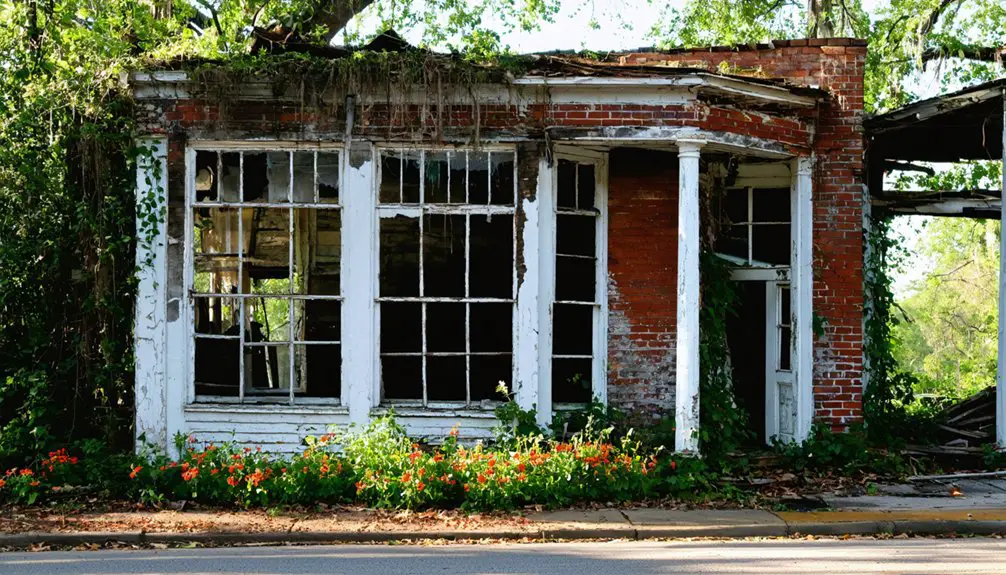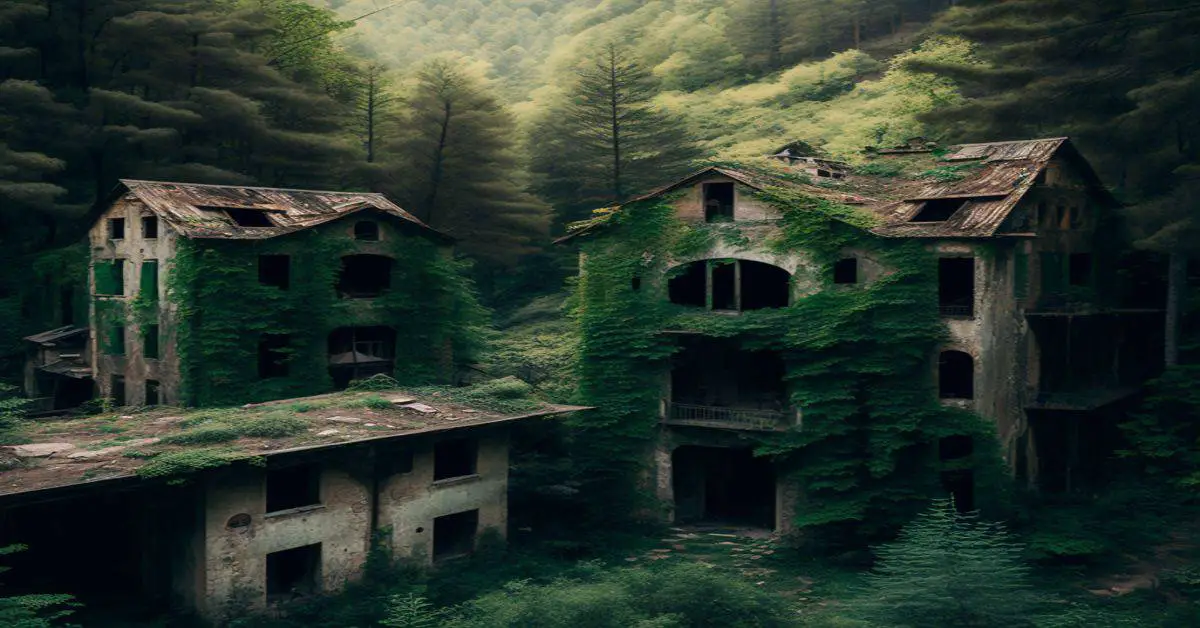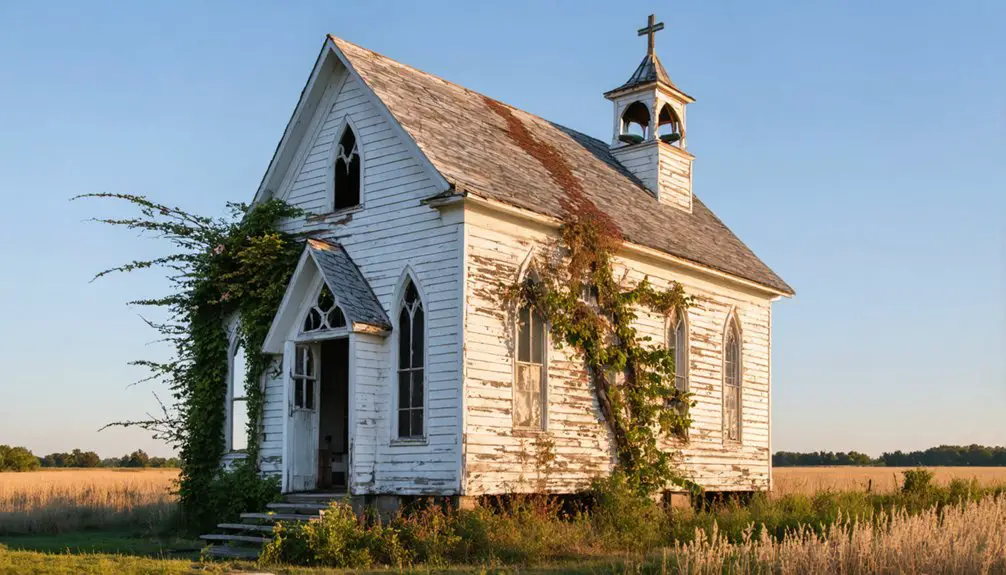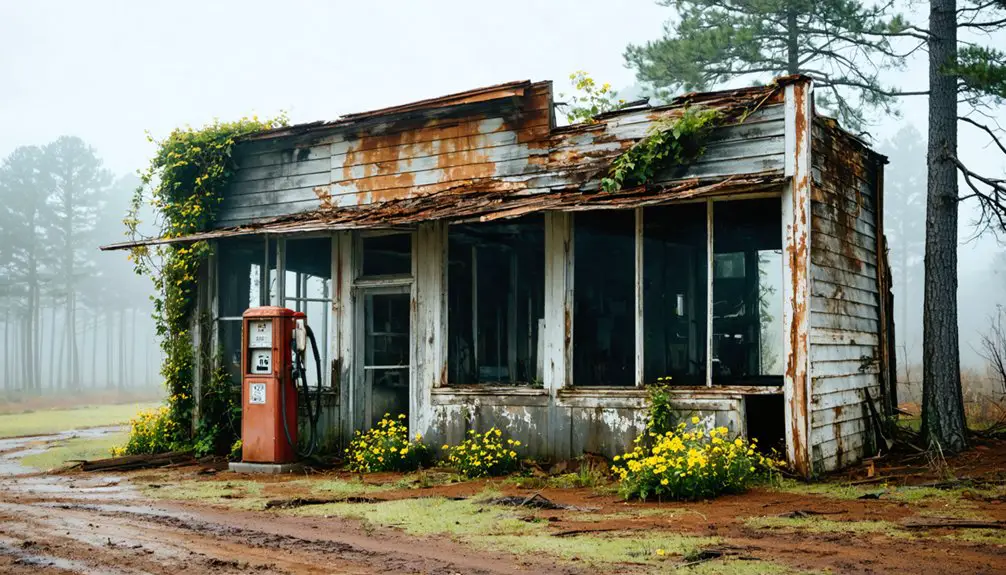You’ll find Rodney, Mississippi’s haunting ruins along what was once a bustling Mississippi River port. In the 1850s, the town thrived with 4,000 residents, surpassing nearby Jackson in size and prosperity. Natural disasters struck hard – the river’s course shifted in 1870, devastating floods swept through in 1912-1935, and fires ravaged the community. Today, you can explore its abandoned churches and scattered remnants, where every crumbling brick tells a story of dramatic rise and fall.
Key Takeaways
- Once a thriving Mississippi River port with 4,000 residents in 1860, Rodney is now an abandoned ghost town.
- The town’s decline began when an 1870 sandbar shift moved the Mississippi River away, destroying its vital port economy.
- Historic structures still standing include Mt. Zion Baptist Church, Sacred Heart Church, and the bullet-marked Presbyterian Church.
- Multiple disasters, including floods, fires, and yellow fever epidemics, contributed to Rodney’s abandonment by the early 1900s.
- The Rodney History and Preservation Society works to protect remaining structures, which gained National Register status in 1972.
The Rise and Glory Days of a River Port Town
While multiple European powers vied for control of the Mississippi Territory between 1722 and 1763, a strategic river crossing point emerged as the settlement of Petit Gulf.
You’ll find this location, later renamed Rodney in 1814, became one of the busiest ports between New Orleans and St. Louis by the 1850s.
The town’s economic prosperity soared as steamboats carried millions of pounds of cotton downstream.
You’d have seen 35 stores, banks, hotels, and professional services flourishing in the bustling business district.
By 1860, Rodney’s population of 4,000 even surpassed nearby Jackson.
At its peak in 1860, the thriving river port of Rodney boasted more residents than Mississippi’s capital city.
The town’s cultural significance grew through its churches, schools, newspapers, and Masonic lodges. For clarity in navigation, modern historians often use place name disambiguation when referencing different locations named Rodney.
Innovation thrived here too – Rush Nutt revolutionized cotton processing with steam-powered gins, while Petit Gulf cotton seeds reached markets as far as North Carolina.
The Sacred Heart Church was constructed in 1868, showcasing the distinctive Carpenter Gothic architectural style that characterized many religious buildings of the era.
Natural Forces Reshape Rodney’s Destiny
Rodney’s reign as a prosperous river port came to an abrupt end in 1870 when nature dealt its first devastating blow. A massive sandbar forced the Mississippi River to shift two miles west, severing the town’s essential connection to river dynamics and commerce.
You’d have witnessed the rapid economic shifts as businesses and families abandoned the area, seeking opportunities elsewhere.
Nature wasn’t finished with Rodney. Catastrophic floods in 1912, 1927, and 1935 repeatedly ravaged the remaining structures, with water reaching church interiors and deteriorating foundations.
The yellow fever epidemics of 1843 and 1847 had already taken a severe toll on the population before the disasters struck.
The town’s resilience was further tested by destructive fires, significantly in 1837, 1852, and 1869, which decimated critical infrastructure. What was once a thriving community of four thousand residents in 1860 dwindled to a shadow of its former self.
Architectural Treasures Lost to Time
Despite the ravages of time, several architectural treasures still stand as silent witnesses to Rodney’s former grandeur.
You’ll find Mt. Zion Baptist Church, built around 1851, showcasing antebellum architectural styles with its Greek Revival elements and distinctive domed cap.
The Sacred Heart Catholic Church, relocated to Grand Gulf Military Park in 1983, represents classic Carpenter Gothic design with its wooden pinnacles and board and batten siding.
At its peak, you’d have seen 35 stores, two banks, and various commercial buildings lining Rodney’s streets.
Today, only scattered remnants remain. The Presbyterian Church, bearing its replica Civil War cannonball, continues to undergo restoration by the Rodney History & Preservation Society.
Behind it, a three-acre cemetery on the bluff holds the stories of Rodney’s past, though many historic grave markers have succumbed to nature’s relentless march.
Stories of War, Fire, and Floods
Throughout the mid-1800s, a series of catastrophic events transformed Rodney from a thriving river port into a vanishing settlement. The war impacts hit hard when Confederate forces shelled the town after capturing Union soldiers at the Presbyterian Church.
Three devastating fires – in 1837, 1852, and 1869 – repeatedly destroyed homes, businesses, and community infrastructure. The 1869 fire tragedy was particularly severe, with flames visible from passing steamboats.
Nature dealt additional blows when the Mississippi River changed course during the Civil War era, leaving Rodney’s port high and dry. Major floods in 1912, 1927, and 1935 submerged buildings, while yellow fever struck in 1843.
These compounding disasters drove residents away, reducing the population from thousands to hundreds by 1900, until Governor Bilbo officially revoked the town’s status in 1930. The final economic blow came when the Jackson and Columbus Railroad bypassed the town, choosing Fayette as its route instead.
Preserving Mississippi’s Hidden Historical Gem
In recognition of Rodney’s profound historical significance, preservation efforts have intensified since 2017 when local advocates established the Rodney History and Preservation Society.
You’ll find their work focused on the iconic Rodney Presbyterian Church, where they’ve maintained authentic Civil War damage, including the signature cannonball replica above the balcony windows.
The town’s cultural significance extends beyond its structures – you’re walking through a place that nearly became Mississippi’s capital in 1817 and was home to Rush Nutt’s revolutionary cotton innovations.
But preservation challenges are immense. Regular flooding threatens the remaining buildings, with waters often reaching church windows.
Despite these obstacles, the 1972 National Register designation helps protect what’s left of this remarkable ghost town, where three churches, 35 stores, and a college once thrived.
Frequently Asked Questions
Are There Any Ghost Hunting or Paranormal Tours Available in Rodney?
You won’t find organized ghost tours or paranormal investigations in Rodney. You’ll need to conduct your own self-guided exploration of the historic church ruins and cemetery on rough, remote roads.
What Happened to the Original Residents’ Descendants After Leaving Rodney?
You’ll find descendants’ stories reveal relocations to Natchez and Jackson for better opportunities, while keeping their community impact alive through preservation societies and church restoration efforts in the original settlement area.
Can Visitors Legally Explore and Photograph the Abandoned Buildings?
Like a forbidden garden, you’ll need permission to explore these grounds. Most buildings are private property, so stick to exterior photography from public roads to avoid trespassing charges.
Is There Current Law Enforcement or Emergency Services Near Rodney?
You’ll find limited law enforcement through Jefferson County Sheriff’s Office and emergency services based in Fayette. Don’t expect quick responses – the nearest help is 20-30 miles from this remote area.
How Many Original Petit Gulf Cotton Plants Still Exist in Rodney?
You won’t find any original Petit Gulf cotton plants in Rodney today – while this location’s cotton heritage was revolutionary in the 1820s, those specific historical plants haven’t survived to modern times.
References
- https://theforgottensouth.com/rodney-mississippi-ghost-town-history-tour/
- https://mississippifolklife.org/articles/haunted-by-a-ghost-town-the-lure-of-rodney-mississippi
- https://en.wikipedia.org/wiki/Rodney
- https://www.tripadvisor.com/Attraction_Review-g28945-d10045204-Reviews-Rodney_Ghost_Town-Mississippi.html
- https://www.legendsofamerica.com/ms-rodney/
- https://msfarmcountry.com/travel/visit-rodney-this-fall/
- https://theforgottensouth.com/rodney-presbyterian-church-history/
- https://backroadplanet.com/haunting-rodney-mississippi/
- https://www.susantregoning.com/blog/rodney-ghost-town
- https://sethparker.net/rodney-mississippi-the-ghost-town-youve-probably-never-heard-of/



